Money is talking big these days in South Florida's art community. So much so that ArtCenter/South Florida of Miami Beach, which houses exhibition spaces and subsidized artist studios, can do much more than "talk the talk" about creating innovative opportunities for artists. Now it can now truly "walk the walk."
First case in point: “Thirty Years on the Road,” a sprawling exhibition curated by Edouard Duval-Carrié at a number of venues on or near Lincoln Road and running through February 1, 2015.
On October 21, 2014, ArtCenter/South Florida announced the sale of its some 17,000-square-foot facility on tourist-congested Lincoln Road for a whopping $88 million. History repeats itself: This building first opened in 1938 as glamorous flagship department store for a company now owned by Macy's. Fast forward to economic downtimes of 1984, when visionary ArtCenter founder Ellie Schneiderman arranged for the center to purchase buildings on a now neglected, dilapidated Lincoln Road, providing affordable workspace and a percolating creative community for visual artists in 21 storefronts.
Still more changing tides in real estate returned the property to its high-end retail roots. The new owner is South Beach Tristar 800, an entity managed by joint owners of W South Beach Hotel and Miracle Mile Shops in Las Vegas, among other properties. At the time of the sale, Tristar president David Edelstein told South Florida Business Journal, "We are pleased to have been successful in the highly competitive process of acquiring what we believe to be the most important retail corner in the state of Florida."
Barely a month after the sale, ArtCenter/South Florida celebrated its 30th anniversary on Lincoln Road with the groundbreaking exhibit, "Thirty Years on the Road," incorporating work by more than 100 artists, dating from the late 1980s to 2014. It's on view at ArtCenter venues on or near Lincoln Road. A major part of this exhibit is at Richard Shack Gallery at 800 Lincoln Road, the facility that sold for $88 million. In May 2015, new owners take possession of this history-laden building.
.
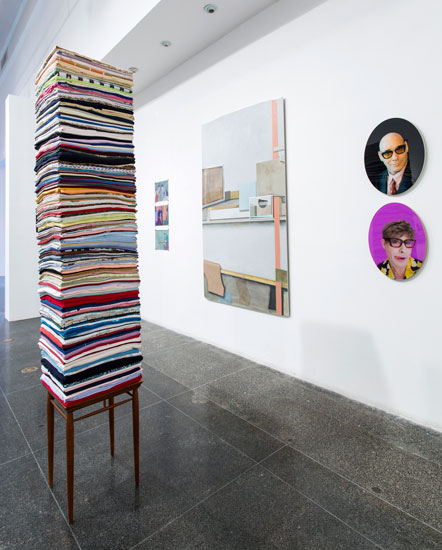
At the Richard Shack Gallery: Artwork by Kerry Philips, Jenny Brillhart and David Rohn. Courtesy of Silvia Ros.
.
So is "Thirty Years on the Road" a swan song for the ArtCenter? "Oh no," said Executive Director Maria del Valle, in an interview on January 6, 2015, in her office at 924 Lincoln Road. "We were celebrating the 30th anniversary regardless of the sale of the building. We didn't know when the sale would happen."
It was a "coincidence," she said, that these two events took place so close in time. Both are, nevertheless, emblematic of the center's bold plans to reinvent itself for the future.
"We are going to be the owners of our destiny," del Valle said. "We want the ArtCenter to bring something unique to artists and to Miami as a community at large." A top priority is establishing an endowment of $50 to $60 million. Additionally, she and her board are considering places in Miami Beach and Miami where the center could buy new property. Paramount is securing an affordable, accessible location big enough for creating artist studio residencies with a competitive international profile.
"We have enough funds to do really great things," she said. "We are going to give artists resources of time, space, and money. If the artists are really good, bright, and talented, they are going to do amazing things."
Given the ArtCenter's history, as illustrated by "Thirty Years on the Road," her claims seem believable. The ArtCenter was first designed to give Miami professional artists’ residencies in the form of affordable studios. That was possible for Schneiderman, a woman of extraordinary determination, in the 1980s when South Beach property was poorly valued and fewer artists were working in Miami. There was a later point, del Valle admitted, when the ArtCenter seemed frozen in time, with the same artists keeping resident studios for years, with little or no change while the surrounding art scene grew much more vibrant.
.

At the Richard Shack Gallery: Artwork by Gavin Perry, Carlos Betancourt, Kerry Philips, David Rohn, Marina Font and Vicenta Casan. Courtesy of Silvia Ros.
.
The exhibition curator, Edouard Duval-Carrié, is an internationally recognized Miami-based artist who once had a studio residency in the center. He also has a track record as an astute curator. One particularly engaging aspect: the show is richly layered to reveal how three decades of Miami art history are deeply entwined with the center's own history.
Studio 101 functions as a compelling archive, with ephemera, timelines, art and newspaper clippings, as well as commissioned broadsheet-formatted publications presented in three chronological segments by former resident artists.
Charo Oquet documents the years 1984-1994 in When Artists Owned the Road and William Cordova documents 1994-2004 in Stairway to Heaven, also including his 1998-1999 video B-Movie. It's a wry, often comic, take-off on movies stereotyping Hispanic men, showing two men fighting each other nonstop on and near Lincoln Road. Kristen Thiele presents "Untitled," with photos covering 2004-2014. In a small gallery, also part of the larger exhibit, there's "ClaySpace Revisited," curated by alumni sculptor James Herring, spotlighting the center's inventive production of ceramic works.
.
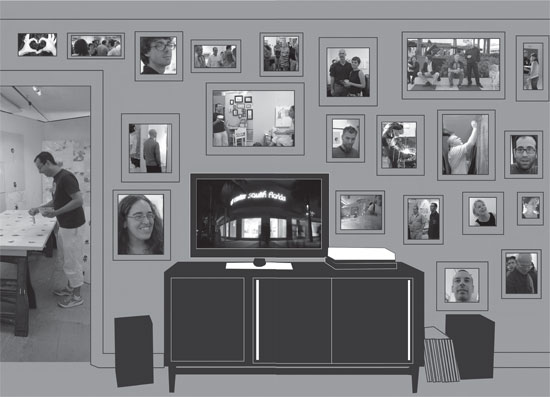
Detail of "Untitled" by Kristen Thiele. Courtesy of Art Center/South Florida.
.
In a section of this show at second-story Project 924 Gallery on Lincoln Road, it's possible to see themes that also weave throughout the elegantly-paced exhibition of works presented in several ArtCenter spaces. Thankfully, the exhibit as a whole doesn't devolve into the visual chaos of too many artworks jammed together. Certainly that was a serious risk.
.
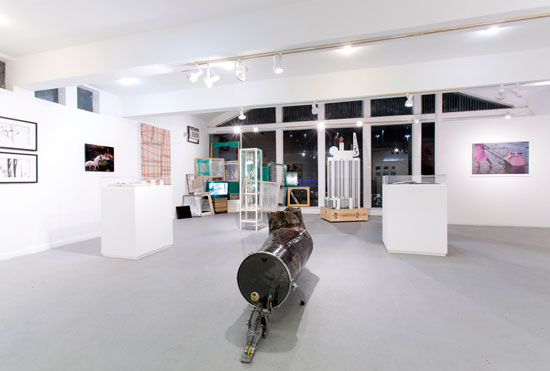
At Project 924: Artwork by Beatriz Monteavaro, Amalia Caputo, Nestor Arenas, Cesar Trasobares, Magnus Sigurdarson and Regina Jestrow. Courtesy of Silvia Ros.
.
Evanescent, flickering patterns of light playing on water as well as foliage and the natural environment, a year-round feature of life in South Florida, constitute the impetus for art in many media. These patterns are manifested in both abstract and more literal ways.
Breathing Beneath the Surface, a stunning video installation by Wendy Wischer, fills the entire space in the East Project Room of Project 924 Gallery. It immerses viewers in dancing, fluid, silvery and gray forms, almost like being underwater in a swimming pool when the sun shines. Except, analogous to a state of grace, this watery environment exudes a sense of timelessness, with no need to break its surface for air.
.
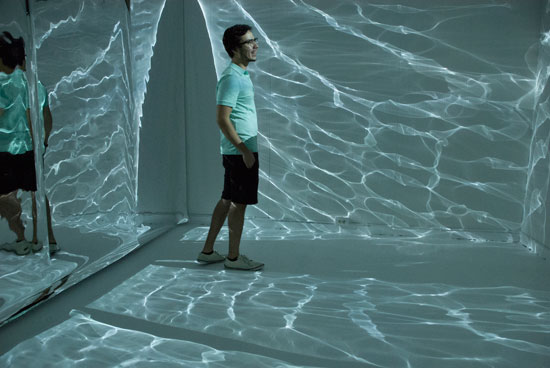
"Breathing Beneath the Surface" by Wendy Wischer. Courtesy of the artist.
.
Forest Silhouette 01-04 by Venessa Monokian deftly bridges abstraction and tiny fragments of landscape with sinuous photographic cutouts of leaves on a flat white ground. Xavier Cortada's mixed media works on paper from his Antarctic Sea Ice Series incorporate sediment from Antarctica's Dry Valleys to create intimate, textured meditations on the fragile vastness of the South Pole, merging abstraction with echoes of geographical and meteorological formations.
.
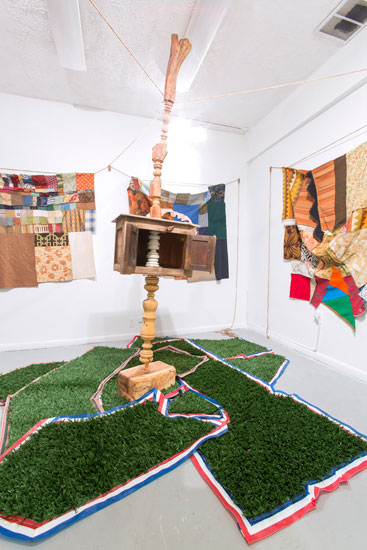
At Project 924: Artwork by Ramon Bofill. Courtesy of Silvia Ros.
.
Dissent and a disavowal of both the preciousness of art objects and the current art market's skyrocketing prices are recurring themes. Some art also involves aspects of performance art, such as the drum created by Beatriz Monteavaro in her junk mail-collaged sculpture Flying Snake. Refined irony pervades Subtropical Gardens by Cesar Trasobares, a glass and steel cabinet displaying hand-held objects like a miniature palm tree, all intricately crafted from dollar bills.
Occupy My Innocence by Magnus Sigurdarson is a scattered installation incorporating empty, shrink-wrapped picture frames and a video with the artist aggressively waving signs with slogans like "What's In It For Me?" and "Occupy My Innocence."
.
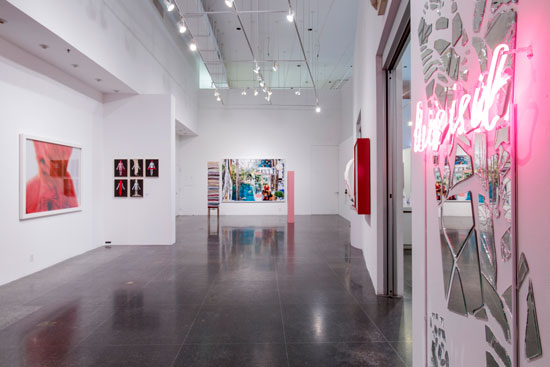
At the Richard Shack Gallery: Artwork by Peter Hammer, Gavin Perry, Carlos Betancourt, Kerry Phillips, Marina Font and Vicenta Casan. Courtesy of Silvia Ros.
.
Easily visited by pedestrians on Lincoln Road, Richard Shack Gallery offers the most public face of this exhibit, particularly with artworks installed in recessed spaces behind street-level, storefront windows.
In this gallery, videos Suddenly We Jump and Suddenly We Jump 2 by Antonia Wright suggest the theme of women pioneering evolving new identities. Wright offers eerily beautiful, frightening images of a woman sinking into water, then rising violently to the surface, as if crashing through rapier shards of glass. That theme recurs elsewhere, as in Nina Surel's Green Velvet, considered a "portrait-landscape" by the artist.
This landscape is one of high-end luxury, embellished with resin-coated decorative elements like jewelry and lace, portraying a double self-portrait. It shows a woman in queenly medieval-like attire next to another elaborately gowned woman nursing an infant. Both faces, each a photographic self-portrait, are frankly contemporary, but the surrounding lushly green "landscape" of gowns and setting suggests both Tolkien fantasies and feminist conflicts between corporate power and motherhood. Marina Font's spare, nuanced works, made with materials including archival prints and yarn, portray a vulnerable female body in several stages of disguise.
.
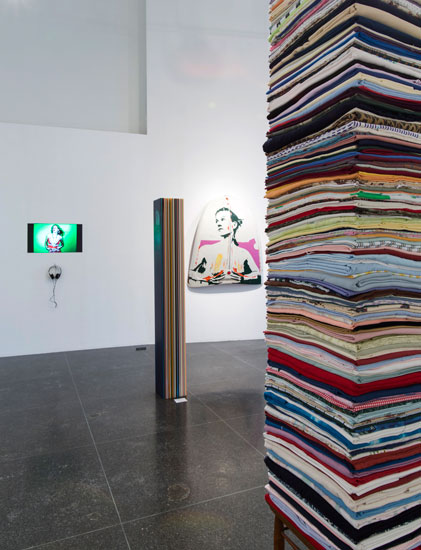
Artwork by Richard Shack, Carlos de Villasante, Luis Gispert, Gavin Perry and Kerry Philips. Courtesy of Silvia Ros.
.
Appropriately, the art here explores times of transition, evoking places and people caught between eras and styles of dramatic contrast. For example, in Luis Gispert's witty, hilarious video Block Watching, a blonde woman, dressed as a cheerleader and bedecked in hip-hop jewelry, dances exuberantly to a car alarm's siren. Deliciously satiric self-portraits by David Rohn, The Money Man and The Creative, recall his performances skewering a status-obsessed art market.
.

At the Richard Shack Gallery: Artwork by Carlos Betancourt, Gavin Perry, David Rohn and Kerry Phillips. Courtesy of Silvia Ros.
.
The large, glossy photographic print of El Portal I (2012) by Carlos Betancourt announces a dreamy, disjointed collage-like composition in which the artist contemplates sources of inspiration, from architecture to tropical vegetation to graffiti. It injects the show with a hefty dose of Miami-infused Magic Realism, transported to the 21st Century.
Storefront installations by Alex Trimino, Federico Uribe, Laz Amaral, Vickie Pierre, and Julie Davidow demonstrate ingenious sensibilities distinguishing this show at its best. Uribe offers his own brand of Miami-infused Magic Realism, hunting and gathering among found objects, mixing residues of past and present. His installation Thingscape is an urban Surrealist's answer to stuffy natural history museum dioramas. A shiny collection of CD's is scattered in one corner to suggest a pool of water. Appearing to rise from that pool is the vintage-looking head of a female mannequin, sporting a swim cap (when did anyone last see a woman wearing a cap in a pool?) crafted from a clunky, similarly dated, computer keyboard.
.
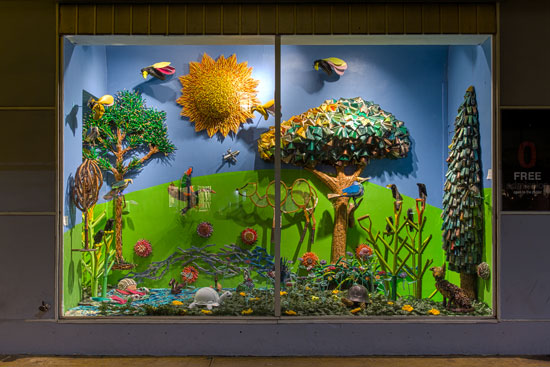
"Thingscape" by Federico Uribe, 2014. Installaion, mixed media, Dimensions variable. Courtesy of Silvia Ros.
.
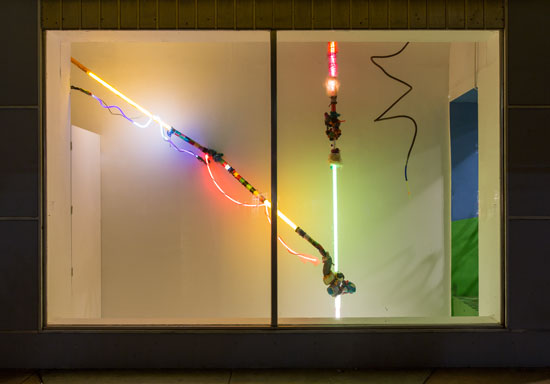
"Fleeing Time" by Alex Trimino, 2014. Installation, mixed media, dimensions variable. Courtesy of Silvia Ros.
.

"Instawindow (Gentrify Development)" by Laz Amaral, 2014. Print and mixed media installation, dimensions variable. Courtesy of Silvia Ros.
.
Vickie Pierre, in her window installation I Can't Say No to You (Good Enough), boldly embraces the curvaceous, even frilly qualities of decorative objects like jewelry and kitschy models of caravels. These objects function as coy reminders of Miami's many links to immigration still shaping the Caribbean. Bringing her strong, purely formal aesthetics to bear on such beguiling decorative elements, Pierre produces work suggesting affinities with paintings by Beatriz Milhazes.
.

"I Can’t Say No to You (Good Enough)" by Vickie Pierre, 2014. Mixed media assemblage, 4.5 feet x 5.5 feet x 5 inches. Courtesy of Silvia Ros.
.
Diagram #29 (Denver Art Museum/Liebeskind) by Julie Davidow features an abstract painting with diagonal bands of muted color, draped with a few lacy echoes of Spanish moss vegetation. Geometric and organic forms are extended from the painting into the surrounding space of her window installation. It's a striking effect, cleverly manipulating two and three dimensions, quietly evoking tensions between built and more fragile natural environments. As sea levels rise, those tensions play out in many parts of the country, yet often seem particularly urgent in low-lying Miami Beach.
.

"Diagram #29" (Denver Art Museum/Liebeskind) by Julie Davidow, 2011. Gesso, acrylic, latex enamel, interference pigment, chrome paint on canvas, with site specific wall mural canvas, 64 x 64 inches.
.
With its many references to the area's subtropical setting and burgeoning art scene, not to mention the rapid rate of change, "Thirty Years on the Road" will surely be remembered as a significant cultural milestone for South Florida.
BASIC INFO: "Thirty Years on the Road," curated by Edouard Duval-Carrié, continues through February 1, 2015, at all Miami Beach locations of ArtCenter/South Florida. For details visit www.artcentersf.org
2015 Copyright Hamptons Art Hub LLC. All rights reserved.
